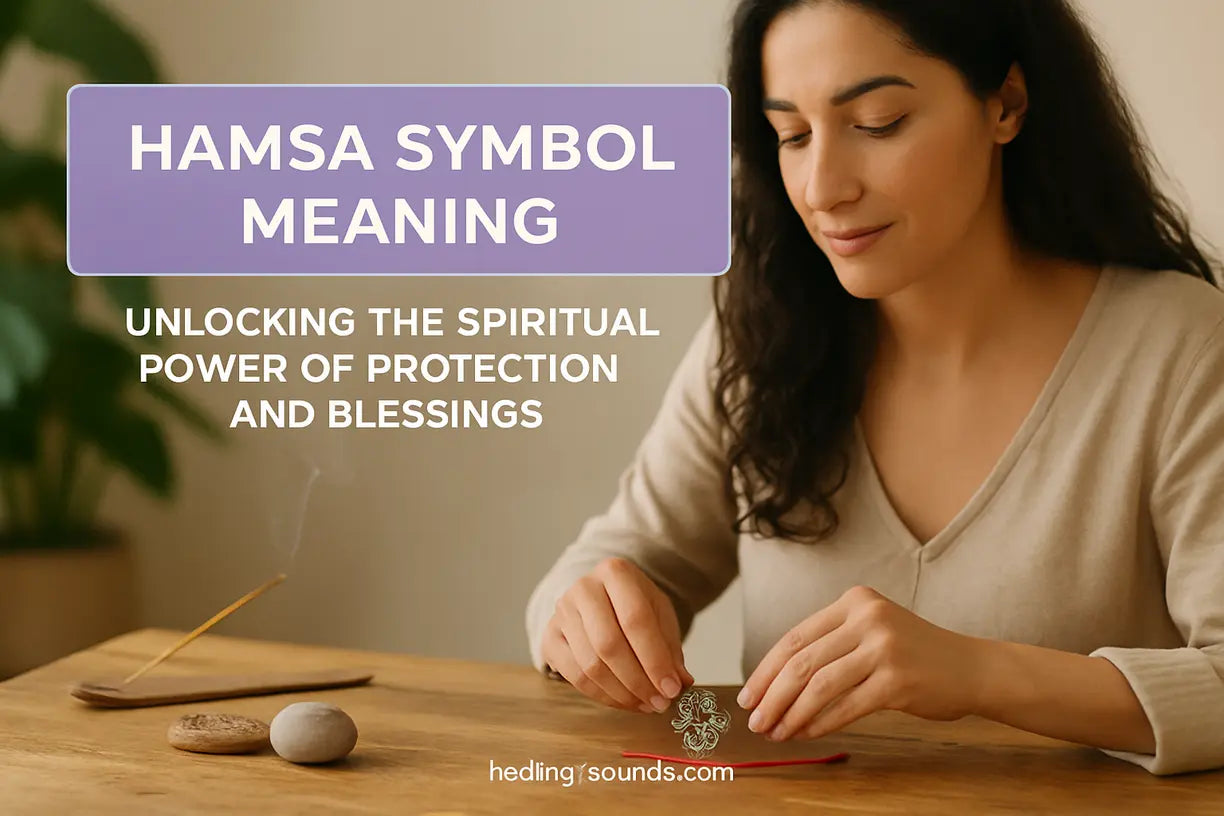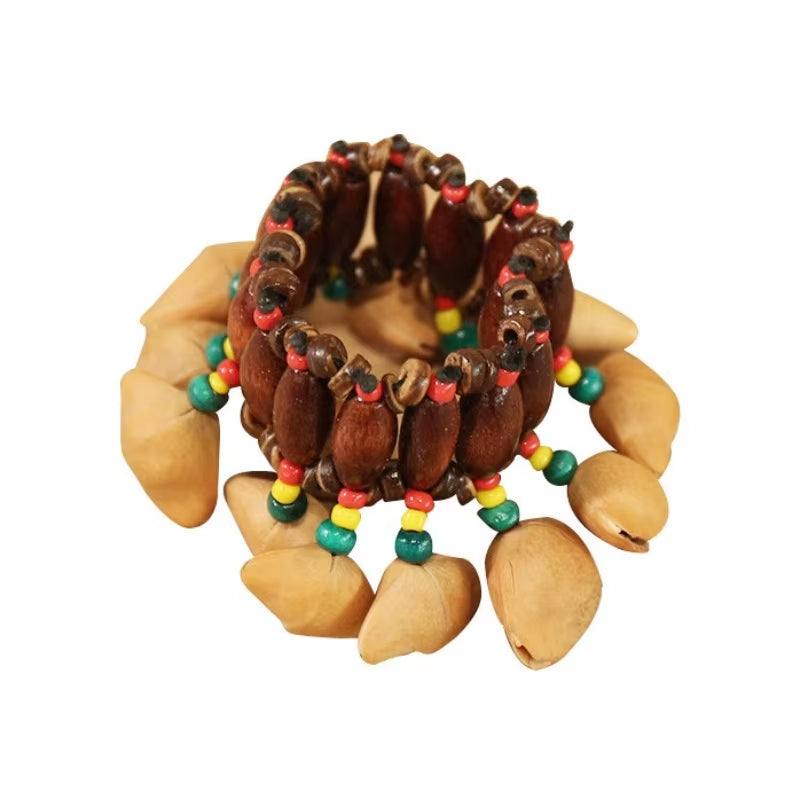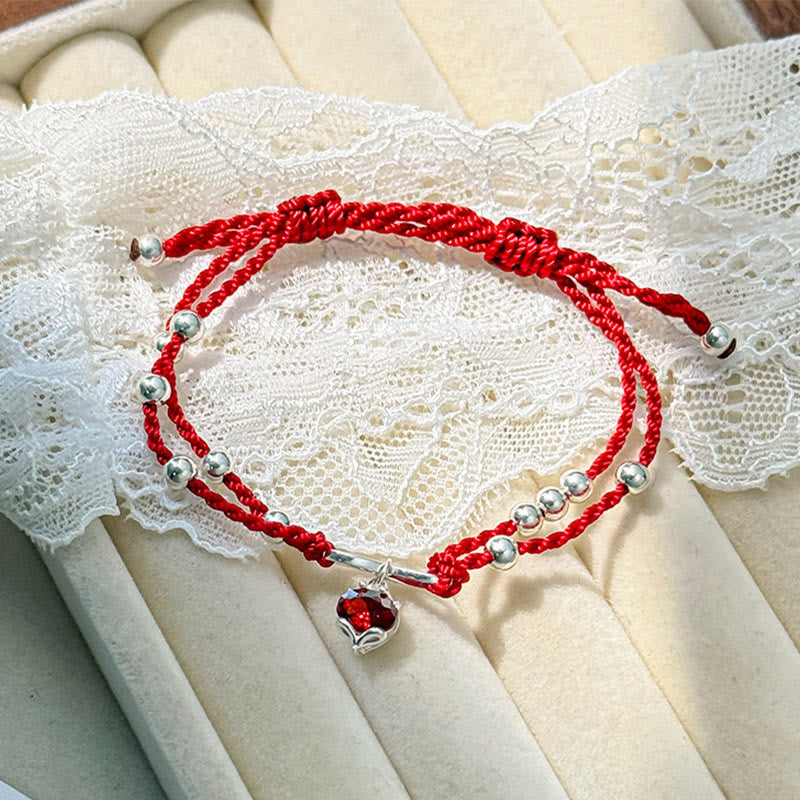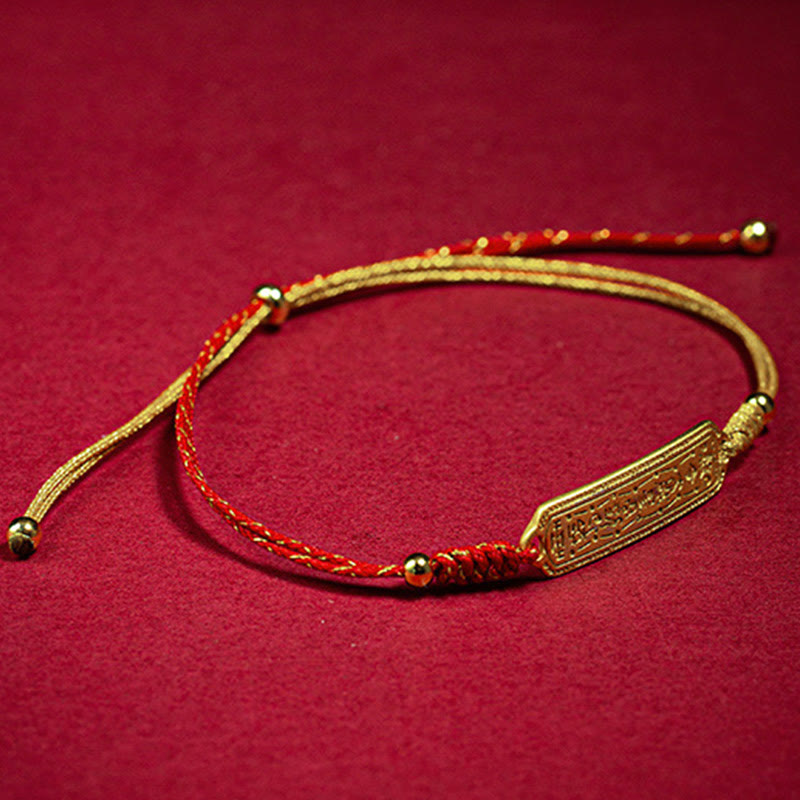Das Bild einer offenen rechten Hand, oft mit einem Auge in der Handfläche, ist ein kraftvolles Symbol, das über Kulturen und Jahrhunderte hinweg bekannt ist. Es handelt sich um die Hamsa, einen uralten Talisman, der für seine tiefe spirituelle Bedeutung verehrt wird. Wenn Sie sich schon einmal von ihrer komplexen Schönheit angezogen gefühlt oder sich über die Bedeutung des Hamsa-Symbols gewundert haben, sind Sie nicht allein. Viele spirituell interessierte Menschen versuchen, ihre schützende, segnende und richtungsweisende Kraft zu verstehen. Dieser Artikel befasst sich mit der reichen Symbolik und den spirituellen Wurzeln der Hamsa und erklärt ihre anhaltende Anziehungskraft und wie sie denen, die sie annehmen, weiterhin Trost und Kraft spendet.
Was ist das Hamsa-Symbol? Enthüllung seiner alten Wurzeln
Die Hamsa, auch Khamsa genannt, ist ein antikes Amulett aus dem Nahen Osten, das symbolisch eine offene rechte Hand darstellt. Ihre Ursprünge gehen vermutlich auf das antike Mesopotamien (heutiger Irak) und Karthago (heutiges Tunesien) zurück. Archäologen haben Hamsa-ähnliche Artefakte aus der Zeit vor vielen großen Religionen gefunden, was auf ihre Wurzeln in frühen heidnischen oder indigenen Glaubensvorstellungen hindeutet. Die Bedeutung der Hamsa ist vielfältig, doch sie wird allgemein als Zeichen des Schutzes anerkannt. Sie ist ein Symbol, das kulturelle und religiöse Grenzen überschritten hat und seinen Platz in jüdischen, islamischen, christlichen, buddhistischen und hinduistischen Traditionen gefunden hat, wobei jede dieser Traditionen ihrer Symbolik einzigartige Facetten verleiht.
Die weite Verbreitung der Hamsa spiegelt das universelle menschliche Bedürfnis nach Schutz und göttlicher Gunst wider. Sie wird oft als „Hand Gottes“ oder schützende Hand gesehen, die vor den bösartigen Kräften des „bösen Blicks“ schützt – einem Blick, der Unglück oder Schaden bringen soll. Die jahrtausendealte Beständigkeit der Hamsa-Symbolik unterstreicht ihre tiefe Verbindung zur menschlichen Spiritualität und dem Streben nach Wohlbefinden.
Die spirituellen Kernbedeutungen des Hamsa-Symbols
Im Kern dreht sich die Bedeutung des Hamsa-Symbols um mehrere spirituelle Schlüsselkonzepte, die bei Menschen, die Führung und positive Energie suchen, großen Anklang finden. Das Verständnis dieser Kernprinzipien kann verdeutlichen, warum dieses alte Symbol auch heute noch so kraftvoll ist.
Schutz: Ein Schild gegen Negativität
Die wichtigste Bedeutung der Hamsa ist Schutz . Sie gilt als mächtiges Amulett, das negative Energien abwehrt, insbesondere den berüchtigten „bösen Blick“. Dieser Glaube an den bösen Blick – einen Blick, der Unglück oder Verletzungen bringen soll – ist in vielen Kulturen weltweit verbreitet. Die Hamsa fungiert als spiritueller Schutzschild, der schädliche Absichten abwehrt und den Träger oder das Zuhause, in dem sie getragen wird, schützt. Die offene Hand gilt als Geste, die Negativität stoppt oder vertreibt und so Sicherheit und Frieden schafft.
Segen, Glück und Kraft
Neben Schutz soll die Hamsa auch Segen, Glück, Glück und Stärke bringen. Sie soll positive Energien anziehen und Glück, Gesundheit und Wohlstand bringen. Viele glauben, dass das Tragen oder Ausstellen einer Hamsa in der eigenen Umgebung eine positive Aura erzeugen und so günstige Umstände und Chancen herbeiführen kann. Die Finger der Hand können auch verschiedene Energien oder Segnungen symbolisieren und werden in einigen Interpretationen mit den fünf Büchern der Thora im Judentum oder den fünf Säulen des Islam in Verbindung gebracht. Diese Verbindung mit positiven Eigenschaften verleiht der Hamsa für viele eine zutiefst persönliche Bedeutung .

Wichtige spirituelle Bedeutungen der Hamsa:
- Göttlicher Schutz: Wehrt den bösen Blick und negative Energien ab.
- Segen und Glück: Zieht Glück, Gesundheit und Wohlstand an.
- Stärke und Kraft: Gibt innere Stärke und Widerstandsfähigkeit.
- Spirituelle Führung: Dient als Verbindung zu einer höheren Macht oder göttlichen Präsenz.
Hamsa-Symbolik: Die Form und Elemente der Hand verstehen
Die visuellen Merkmale der Hamsa sind reich an Symbolik. Die Art und Weise, wie die Hand dargestellt wird, sowie andere Motive, die oft in ihr Design integriert sind, verleihen der Bedeutung des Hamsa-Symbols weitere Ebenen.
Die Hand selbst: Aufrecht oder nach unten gerichtet
Die Hamsa-Hand kann auf zwei grundlegende Arten dargestellt werden: mit nach oben oder nach unten zeigenden Fingern. Wenn die Finger nach oben zeigen, wird dies oft als universelles Zeichen gegen das Böse gesehen, eine Geste zur Abwehr von Negativität. Diese Position kann auch Schutz und die Abwehr schädlicher Einflüsse darstellen. Wenn die Finger nach unten zeigen, wird die Hamsa oft als Symbol für Überfluss und Segen interpretiert, das Glück und Positivität in das eigene Leben bringt. Diese Position wird in buddhistischen und hinduistischen Traditionen manchmal Varada Mudra genannt und symbolisiert die Erfüllung von Wünschen oder Wohltätigkeit. Die Ausrichtung ändert nichts grundsätzlich an der schützenden und wohlwollenden Natur des Symbols, kann aber verschiedene Aspekte seiner Macht betonen.
Häufige Symbole innerhalb der Hamsa: Das Auge, der Fisch und mehr
Oftmals weist die Hamsa in ihrer Handfläche weitere wirkungsvolle Symbole auf, die ihre Bedeutung verstärken:
- Das Auge (Auge des Horus oder böser Blick): Ein Auge in der Handfläche der Hamsa ist vielleicht die häufigste Ergänzung und ein mächtiges Symbol des Schutzes vor dem bösen Blick. Es stellt das allsehende Auge dar, das über den Träger wacht und ihn beschützt. Dieses „Zurückstarren“ auf böswillige Blicke soll deren Macht neutralisieren.
- Fische: In manchen Traditionen werden Fische auf der Hamsa als Symbol für Glück und Fruchtbarkeit dargestellt. Fische sind außerdem immun gegen den bösen Blick, da sie unter Wasser leben, was die schützenden Eigenschaften des Amuletts zusätzlich verstärkt.
- Davidstern: In der jüdischen Kultur kann die Hamsa manchmal einen Davidstern enthalten, was ihre Verbindung zum Judentum und zum göttlichen Schutz verstärkt.
- Farben: Die Farbe Blau, insbesondere ein tiefes oder Türkisblau, wird häufig in Hamsa-Amuletten verwendet, da sie in vielen Kulturen des Mittelmeerraums und des Nahen Ostens auch als Schutzfarbe gegen den bösen Blick gilt.
Das Verständnis dieser Elemente hilft dabei, die Tiefe und Vielseitigkeit der spirituellen Bedeutung der Hamsa-Hand zu verstehen, wie sie sich durch verschiedene kulturelle Interpretationen entwickelt hat.

Die schützenden Eigenschaften der Hamsa werden oft durch Amulette und Talismane vermittelt. Das Tragen einer Hamsa kann als ständige Erinnerung an diese positiven Energien dienen.
Natürliches Muschelglockenarmband - Afrikanische Trommelrassel
$19.99
Verleihen Sie Ihrer spirituellen Praxis Schutz und Harmonie mit dieser natürlichen Muschelglockenrassel, die von heiligen Amuletttraditionen inspiriert ist.
Produkt entdeckenDie Hamsa-Hand in verschiedenen Kulturen und Religionen
Einer der faszinierendsten Aspekte der Hamsa ist ihre weitverbreitete Verwendung und Interpretation in verschiedenen Glaubensrichtungen und Kulturen. Diese kulturübergreifende Anziehungskraft unterstreicht das universelle menschliche Verlangen nach Schutz, Segen und der Verbindung zum Göttlichen. Die Definition der Hamsa kann leicht variieren, doch ihr Kern bleibt gleich.
Hamsa im Judentum
In der jüdischen Tradition wird die Hamsa oft als „Hand Mirjams“ bezeichnet, in Anlehnung an Mirjam, die Schwester von Moses und Aaron. Die fünf Finger werden manchmal mit den fünf Büchern der Tora (dem Pentateuch) in Verbindung gebracht. Sie ist ein verehrtes Symbol für Schutz und Glück und findet sich häufig in Häusern, auf Schmuck und Gegenständen für religiöse Rituale. Für viele Juden ist die Hamsa eine Erinnerung an Gottes schützende Hand. Weitere Informationen zur Symbolik in verschiedenen Kulturen finden Sie in Quellen wie der Heilbrunn Timeline of Art History des Metropolitan Museum of Art, die Symbole in verschiedenen Kontexten behandelt.
Hamsa im Islam (Hand der Fatima)
In der islamischen Kultur ist die Hamsa als „Hand der Fatima“ bekannt, benannt nach Fatima Zahra, der Tochter des Propheten Mohammed. Die fünf Finger sollen die fünf Säulen des Islam repräsentieren: Schahada (Glaube), Salat (Gebet), Zakat (Wohltätigkeit), Sawm (Fasten) und Hadsch (Pilgerfahrt nach Mekka). Wie in anderen Traditionen ist sie ein wirksames Symbol gegen den bösen Blick und wird verwendet, um göttlichen Schutz, Segen und Stärke zu erbitten. Die Frage nach der Bedeutung der Hamsa im Islam wird oft mit Verweisen auf Fatimas Reinheit und Macht beantwortet.
Hamsa in anderen Traditionen
Der Einfluss der Hamsa beschränkt sich nicht nur auf abrahamitische Religionen. Im Buddhismus und Hinduismus symbolisiert die offene Hand (Abhaya Mudra) Furchtlosigkeit, Schutz und Konfliktlösung. Obwohl sie nicht immer mit der Hamsa des Nahen Ostens identisch ist, ist die visuelle und symbolische Bedeutung einer offenen, schützenden Hand ein wiederkehrendes Thema. Levantische koptische Christen bezeichnen sie manchmal als die Hand Mariens. Die Präsenz des Symbols in diesen Traditionen unterstreicht das gemeinsame menschliche Verständnis der Hand als Kanal der Macht und göttlichen Intervention. Die universelle Frage, was die Hamsa symbolisiert, wird in diesen verschiedenen Glaubensrichtungen oft mit ihren schützenden und segnenden Eigenschaften beantwortet.
Umfassen Sie Schutz und Positivität mit symbolischem Schmuck
$35.90
$51.90
Erleben Sie uralte Schutzenergien und ziehen Sie mit diesem eleganten roten Schnurarmband, das Verbundenheit und Glück symbolisiert, Positives an. Mehr erfahren ➔
$24.90
$35.90
Bekennen Sie sich zur beständigen Tradition des spirituellen Schutzes mit diesem roten Kordelarmband mit Goldakzenten, einem zeitlosen Symbol des Schutzes. Mehr erfahren ➔
Das Hamsa-Symbol heute tragen und verwenden
Auch heute noch ist die Hamsa ein beliebtes Symbol, das sowohl für seine ästhetische Schönheit als auch für seine anhaltende spirituelle Kraft geschätzt wird. Menschen integrieren die Bedeutung des Hamsa-Symbols auf vielfältige Weise in ihr Leben und suchen nach seinen schützenden und wohlwollenden Energien.
Schmuck, Amulette und Wohndekor
Der häufigste Weg, mit der Hamsa in Kontakt zu treten, ist Schmuck. Halsketten, Armbänder, Ohrringe und Ringe mit der Hamsa werden häufig als persönliche Amulette getragen. Diese Stücke dienen als ständige Erinnerung an die schützenden Eigenschaften des Symbols und seine Fähigkeit, Glück anzuziehen. Über den persönlichen Schmuck hinaus ist die Hamsa auch ein beliebtes Motiv in der Inneneinrichtung. Wandbehänge, Wandteppiche und Dekorationsobjekte mit der Hamsa werden verwendet, um einen heiligen und geschützten Raum im Haus zu schaffen und ihren schützenden Einfluss auf den gesamten Haushalt auszudehnen. Die spirituelle Bedeutung der Hamsa-Hand wird so zu einem integralen Bestandteil des persönlichen und häuslichen Umfelds.

Respektvoller Umgang mit einem heiligen Symbol
Angesichts seiner tiefen kulturellen und religiösen Wurzeln ist es wichtig, dem Hamsa-Symbol respektvoll zu begegnen. Obwohl es universelle Anziehungskraft hat, kann das Verständnis seiner Ursprünge und Bedeutung in bestimmten Traditionen die eigene Verbindung zu ihm stärken. Wenn Sie sich dafür entscheiden, eine Hamsa zu tragen oder zu zeigen, verstärkt dies ihre Bedeutung, indem Sie ihre Geschichte und die damit verbundenen Glaubensvorstellungen würdigen. Wer sich für den breiteren Kontext symbolischer Objekte in kulturellen Praktiken interessiert, kann durch die Untersuchung kulturanthropologischer Ressourcen, beispielsweise Materialien der American Anthropological Association , wertvolle Einblicke in das Verständnis und die Verehrung von Symbolen in verschiedenen Gesellschaften gewinnen.
Tipps für respektvollen Umgang:
- Lernen Sie seine Geschichte kennen: Verstehen Sie die kulturelle und religiöse Bedeutung der Hamsa.
- Absichtliche Verwendung: Tragen oder zeigen Sie es mit einer bewussten Absicht, sei es zum Schutz, als Segen oder als spirituelle Erinnerung.
- Quelle: Unterstützen Sie nach Möglichkeit Kunsthandwerker oder Verkäufer, die den Ursprung des Symbols respektieren.
- Persönliche Verbindung: Lassen Sie zu, dass die Bedeutung des Symbols mit Ihrem eigenen spirituellen Weg und Ihren Werten in Einklang steht.
Die anhaltende Kraft der Hamsa
Die Bedeutung des Hamsa-Symbols ist ein reiches Geflecht aus Fäden alter Glaubensvorstellungen, vielfältiger kultureller Interpretationen und der universellen menschlichen Sehnsucht nach Schutz, Segen und spiritueller Verbundenheit. Von seinen Ursprüngen im antiken Nahen Osten bis zu seiner heutigen weiten Verbreitung ist die Hamsa ein kraftvolles Symbol positiver Energie und göttlichen Schutzes. Ob Sie sich von seinen komplexen Designs, seiner geschichtsträchtigen Geschichte oder der tiefgründigen Hamsa-Hand-Symbolik angezogen fühlen, dieses antike Amulett vermittelt eine zeitlose Botschaft der Hoffnung und Stärke.
Wenn Sie die spirituelle Bedeutung und die vielfältigen Verehrungsformen verstehen, können Sie die schützenden und wohlwollenden Energien der Hamsa in Ihr Leben einladen. Entdecken Sie, wie dieses kraftvolle Symbol Ihre spirituelle Reise unterstützen und Ihnen ein Gefühl von Frieden und Verbundenheit zu etwas Größerem vermitteln kann. Wir von Healing Sounds glauben an die Kraft solcher Symbole, das Wohlbefinden zu steigern, und laden Sie ein, Gegenstände zu entdecken, die mit Ihrem Geist in Resonanz treten.
Häufig gestellte Fragen zur Bedeutung des Hamsa-Symbols
Die Hamsa-Hand symbolisiert in erster Linie Schutz vor dem bösen Blick und negativen Energien . Sie gilt auch als Symbol für Segen, Glück, Stärke und Gesundheit . Die offene rechte Hand gilt als universelles Zeichen der Verteidigung und des göttlichen Schutzes.
Ja, das Tragen einer Hamsa ist grundsätzlich in Ordnung, unabhängig vom religiösen oder kulturellen Hintergrund, da ihre Symbolik des Schutzes und Segens universelle Anziehungskraft hat. Es wird jedoch immer empfohlen, sie mit Respekt und Verständnis für ihre tiefen kulturellen und spirituellen Ursprünge zu tragen. Die Wertschätzung ihrer Bedeutung verstärkt ihre persönliche Bedeutung.
Im Islam wird die Hamsa oft als „Hand der Fatima“ bezeichnet, benannt nach Fatima Zahra, der Tochter des Propheten Mohammed. Sie symbolisiert Schutz, Segen, Macht und Stärke . Die fünf Finger werden manchmal als die fünf Säulen des Islam interpretiert.
Während die Hamsa in ihrer spezifischen Darstellung (oft mit einem Auge) vorwiegend aus dem Nahen Osten und Nordafrika stammt, weist die Geste der offenen Hand symbolische Parallelen im Hinduismus auf. Das Abhaya Mudra , eine Geste der offenen rechten Hand, die „Furchtlosigkeit“ bedeutet, ist in der hinduistischen (und buddhistischen) Ikonographie ein gängiges Symbol für Schutz und Zuversicht. Obwohl es sich nicht um dasselbe Symbol handelt, hat das Konzept einer schützenden Hand eine ähnliche Bedeutung.
In verschiedenen Kulturen behält das Hamsa-Symbol im Allgemeinen seine Kernbedeutung : Schutz, insbesondere vor dem bösen Blick, und als Anziehungspunkt für Glück und Segen . Im jüdischen Kulturkreis ist es die Hand Mirjams; im levantinischen Christentum kann es die Hand Mariens sein. Seine weite Verbreitung unterstreicht das gemeinsame Verständnis der Hand als kraftvolles Symbol göttlichen Eingreifens und Schutzes.







